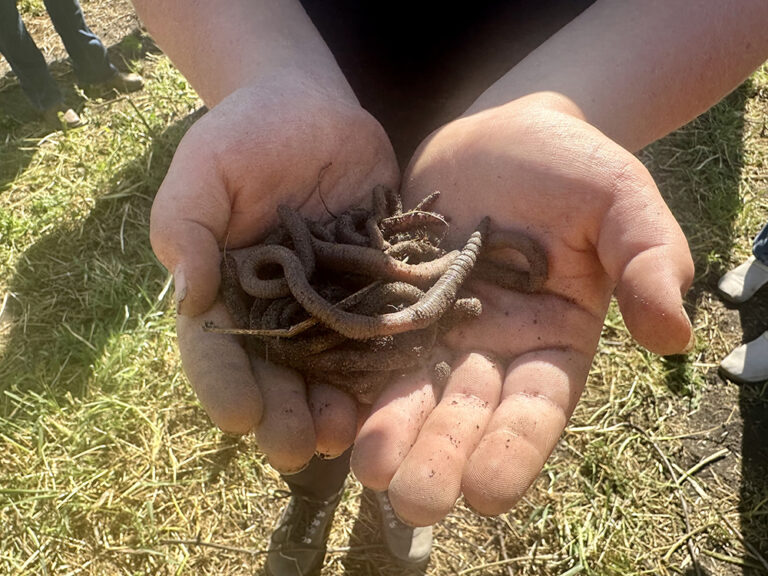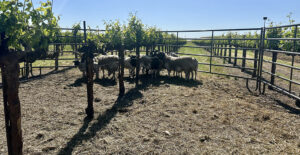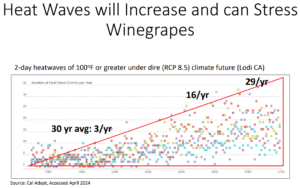
Several hundred wine producers came together April 30 and May 1, 2024 for a broad-ranging, two-day conference in Lodi for the third Sustainability Summit sponsored by Wine Institute’s California Sustainable Winegrowing Alliance (CSWA). Day 1 was devoted to field trips showcasing on-farm practices at two California Green Medal-winning sites, who are part of Lodi Rules (a stricter set of practices than CSWA), while Day 2 presented a series of speakers and panels from major wine-growing regions, including New York, Washington, Oregon and California.
Experts shared their recommendations on how to cultivate resilience with consumers, government and nature.

1. Boost Wine Industry’s Appeal with Sustainable Practices
As wine sales decline and consumers drink less alcohol overall (across beer and spirits as well as wine), Robert P. Koch, Wine Institute’s president and CEO, told the audience wine is going on a new communications initiative to combat anti-alcohol trends and said showcasing the wine industry’s commitment to sustainability is a plus.
“It promotes positive public relations to help ensure a halo effect for wine,” he said. “By focusing on sustainable winegrowing and working together, we can build resiliency while adding to a compelling story to share with
the world.”
2. Tell Consumers Specifics About Your Wine and Sustainability Practices
Along the same lines, Liz Thach, MW, President, Wine Market Council, and former Sonoma State University professor of wine business, told wineries to let consumers know more about specific sustainability actions and recommended seven action items for wineries to take.
Steps include calling out farming practices on your labeling and packaging, creating a special tab on your website to showcase sustainability and providing specific statistics on your progress toward sustainability (i.e., “70% of energy is powered by wind.”)
As the U.S. consumer demographic becomes more multicultural, she recommended hiring a more diverse workforce to reflect that increasing diversity. Proactively communicating high-level nutritional information (“no added sugar, 120 calories per serving”) helps, too, she said, as well as making at least one wine under 12% alcohol. A final tip: Offer sustainability tours at your winery.
3. Encourage Biodiversity
LangeTwins Winery and Vineyards in Acampo, Calif. farms more than 7,000 acres of vines. Aaron Lange, head of vineyard operations, brought visitors to see the company’s biodiversity initiative, which includes restoring a four-acre area near their tasting room into a habitat of pollinators in a partnership with pollinator experts Xerces Society.
The winery has also installed two miles of hedgerows of native species (coyote bush, quail brush sage, milkweed, toyon, redbud and salvia) around vineyard perimeters to increase biodiversity. They are also trying out the use of vermiculture to enhance soil health on a pilot project.
4. Put Worms to Work to Improve Soil Health
KG Vineyards Co-Owner and Sustainability Director Madelyn Kolber and her son Judah demonstrated the value they get from worms in their soil as Judah delivered a prepared talk and then showed wriggling worms to visitors. The worms improve soil health at low cost, they said.

The team also uses sheep to fertilize and mow its vineyards. They farm 2,000 acres.
At another station at KG’s The Camp, Charlie Hamilton, viticulture and operations manager, explained the various soil types visitors could see in a soil pit showing blue soils deep down below clay layers.
5. Get Ready for More Frequent Heat Events and Increased Pest Pressures
Steven Ostoja, Ph.D., director of USDA’s California Climate Hub, warned climate warming will accelerate from an average of three heat events to 16 by mid-century and more than 29 a year by the end of the century.
The increased heat is also expected to bring in new invasive species and increase insects’ reproduction rates.
Both of those factors will change the way plants behave, Ostoja said.
“This is the single most frightening dynamic to me… We lost 129 million trees in the 2012-16 drought to a bark beetle that was not even on the radar,” he said.
Even more worrying, Ostoja mentioned research by UC Merced’s Tapan Pathak, associate professor and a specialist in climate adaptation in agriculture, shows climate warming effects will turbocharge insect reproduction rates and invasions.
Ostoja suggested mitigating heat by planting trees in vineyards and irrigating in advance of heat events.
More research from Ostoja’s group is available on the USDA Climate hub website and in the USDA climate adaptation resources workbook on California specialty crops.
He also cited a new April 2024 paper, A variety-specific analysis of climate change effects on California winegrapes, authored by the USDA California Climate Hub and partners, with additional information and insights.
Resources
Climate change impacts and actionable strategies for mitigation (from Steven Ostoja, Ph.D.): https://drive.google.com/file/d/1WzI54AkP6ey9ejh5yD4BaTP3FzPOUnEn/view?usp=sharing
USDA California Climate Hub: https://www.climatehubs.usda.gov/hubs/california
USDA Climate Adaptation Resources Workbook: https://www.climatehubs.usda.gov/hubs/california/topic/adaptation-resources-workbook-california-specialty-crops
Climate change effects by winegrape variety: https://link.springer.com/article/10.1007/s00484-024-02684-8











